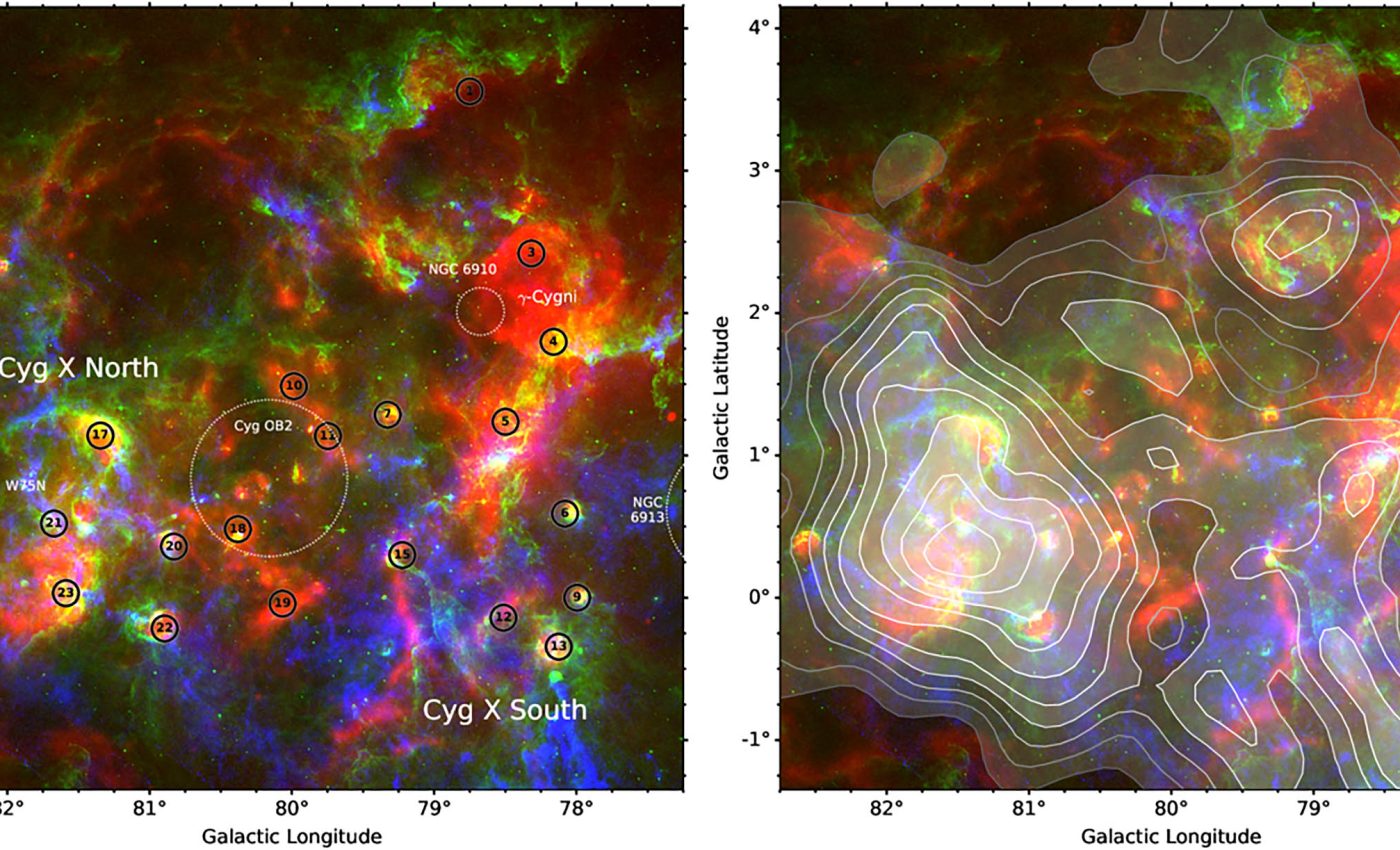
New material called 'CO-dark molecular gas' discovered in the Cygnus X region
New maps reveal a vast store of hidden star-making material called “CO-dark molecular gas” in the Cygnus X region – a stellar-mass black hole and a blue supergiant star. The team traced it across about 30 square degrees using a giant radio telescope.
CO-dark molecular gas, molecular hydrogen that lacks carbon monoxide (CO) glow so ordinary maps miss it. It sits roughly 5,000 light years from Earth in one of the galaxy’s busiest nurseries.
CO-dark molecular gas in Cygnus X
By tuning to carbon radio recombination lines, faint radio fingerprints from electrons joining carbon ions, the scientists uncovered arcs, ridges, and threads of cold gas.
These structures wrap around known molecular clouds and fill in the missing pieces of star formation.
“These observations underline the richness of low-frequency CRRLs,” wrote Kimberly L. Emig, lead author at the National Radio Astronomy Observatory (NRAO), who led the observations with the Green Bank Telescope.
The map marks the first time this hidden component has been charted over such a wide patch of sky.
The work connects unseen raw material directly to where young stars are growing. Early results show CO-dark molecular gas is not static. It shifts and flows, gathering where future star clouds will thicken.
Invisible star fuel
Astronomers often track star fuel with CO, which shines brightly in radio light. But CO misses a large share of hydrogen because starlight can break CO apart while H2 survives.
A landmark gamma ray analysis first revealed big reservoirs of such dark gas around nearby clouds. That finding hinted that every star forming region might harbor a hidden budget.
A classic model shows this dark fraction depends on the distance that far ultraviolet radiation can reach into a cloud. Where dust shields the light, CO returns and ordinary tracers light up.
The new map targets the borderlands where hydrogen turns molecular but carbon stays ionized. That is exactly where carbon’s radio lines become most useful.
Tracking CO-dark molecular gas
The team stacked many carbon lines at low radio frequencies to boost sensitivity. That allowed them to outline cold layers that sit just outside the bright CO cores.
They found that carbon emission often lies offset from CO by tens of light years. The typical separation was about 39 light years, a clue to where molecules first assemble.
The map’s fine patterns suggest photodissociation regions, gas where starlight breaks molecules apart, are sprawling and structured. Ridges and sheets show up where radiation sculpts cloud edges.
These layers reveal how ordinary matter is processed before it becomes dense star forming gas. That view was missing in earlier surveys.
Moving gas in Cygnus X
Velocities add another layer of insight. Across the region, carbon features often move differently from the CO cores by roughly 1.8 miles per second.
Those offsets imply turbulence, motion driven pressure from chaotic gas flows, is doing real work on the gas. In Cygnus X, that motion appears strong enough to set the pace for building molecules.
The data also show that carbon lines are wider than expected for purely cold, quiet gas. That extra width signals a mix of flows and overlapping streams.
Together, the motions and widths point to fast recycling of material. Gas is stirred, cooled, and fed into forming clouds on surprisingly short timescales.
Starlight shapes gas
The brightness of the carbon lines rises with the glow from small dust grains at 8 microns. That glow traces starlight bathing the gas.
A survey found that ionized carbon [C II] brightness tracks the 8 micron signal in a non linear way. The new map shows a similar trend for carbon’s radio lines, tying them to the local radiation field.
That link matters, because radiation sets the temperature of the thin, outer cloud layers. Warmer layers cool mainly through carbon, which explains why the radio lines respond so clearly.
In Cygnus X, the inferred starlight is stronger than average, which fits a region packed with hot, young stars. The carbon map therefore doubles as a radiation meter.
Early star clues
Star formation begins well before gas shows up in CO. The new data capture that earliest stage and place it next to the familiar CO bright cores.
Because the method uses carbon’s radio fingerprint, it also avoids confusion from other bright lines. That gives a clean view of the molecular cloud, a dense, cold gas region where stars form, as it assembles.
The map’s wide coverage reveals how many different environments share this hidden phase. Some carbon ridges hug CO peaks, while others span more diffuse zones.
That diversity helps explain why star forming clouds grow at different speeds. It also gives modelers a sharper target for simulating how gas becomes stars.
Next steps for CO-dark molecular gas
The same radio technique can be applied across the Milky Way. Larger surveys will test whether the patterns found in Cygnus X hold elsewhere.
Improved sensitivity will shrink the uncertainty on line widths and flows. That will refine how much of the gas is actively accreting and how much is being pushed away.
Comparisons with polycyclic aromatic hydrocarbons, carbon ring molecules that glow in infrared, and with [C II] maps will add more detail. Those checks will pin down which layers carry most of the cooling.
Every added region will tighten the link between hidden gas, radiation, and star birth. The carbon lines offer a fresh, practical path to do it.
The study is published in The Astrophysical Journal.
—–
Like what you read? Subscribe to our newsletter for engaging articles, exclusive content, and the latest updates.
Check us out on EarthSnap, a free app brought to you by Eric Ralls and Earth.com.
—–













